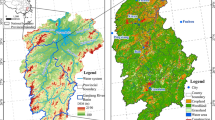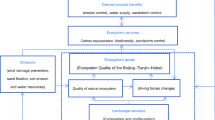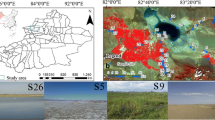Abstract
In recent years, there has been an increase in the quantity of marsh ecological asset (MEA) on the Qinghai-Tibetan Plateau due to climatic warming and humidification. However, the alterations in the quality of the MEA in this region remain unclear. Here, we constructed a marsh quality index (MQI) based on the structural (including marsh fractal dimension, FD; and river network density, RN) and functional (including river runoff, Rr; and Normalized Difference Vegetation Index, NDVI) indices of marshes to assess the change in the quality of MEA between 1980 and 2020 in the pastoral areas of Zoige County. We also examined changes in MEA quantity. And the relationships between the MEA and environmental variables were tested using grey relational analysis. We found that the quantity of MEA experienced an increase of 564.41 km2 from 1980 to 2020 in the pastoral areas of Zoige County. This rise was mainly due to the conversion of grassland into marsh. The MQI results demonstrated that there was a steady improvement in the quality of MEA, which was mainly attributed to the increase in RN, Rr, and NDVI. While the quantity and quality of MEA showed a strong association with climatic factors, their correlation with livestock numbers was found to be weak. These findings suggest that changes in MEA are strongly controlled by climate change and thus nature-based approaches should be highlighted for the conservation and management of MEA in plateau regions.






Similar content being viewed by others
Data Availability
The datasets generated during and/or analysed during the current study are available from the corresponding author on reasonable request.
References
Bai J, Lu Q, Wang J et al (2013) Landscape pattern evolution processes of alpine wetlands and their driving factors in the Zoige Plateau of China. Journal of Mountain Science 10:54–67
Bai J, Ouyang H, Cui B et al (2008) Changes in landscape pattern of alpine wetlands on the Zoige Plateau in the past four decades. Acta Ecologica Sinica 28:2245–2252
Benoit M (1977) Fractals: form, chance and dimension. WH Freeman and Company, New York City
Chen H, Zhu Q, Peng C et al (2013) The impacts of climate change and human activities on biogeochemical cycles on the Qinghai-Tibetan Plateau. Global Change Biology 19:2940–2955
Cohen MJ, Carstenn S, Lane CR (2004) Floristic quality indices for biotic assessment of depressional marsh condition in Florida. Ecological Applications 14:784–794
Conway D, Schipper ELF (2011) Adaptation to climate change in Africa: Challenges and opportunities identified from Ethiopia. Global Environmental Change 21:227–237
Cui Q, Wang X, Li D, Guo X (2012) An ecosystem health assessment method integrating geochemical indicators of soil in Zoige wetland, southwest China. Procedia Environmental Sciences 13:1527–1534
Daily GC, Söderqvist T, Aniyar S et al (2000) The Value of Nature and the Nature of Value. Science 289:395–396
Dangles O, Rabatel A, Kraemer M et al (2017) Ecosystem sentinels for climate change? Evidence of wetland cover changes over the last 30 years in the tropical Andes. PLoS One 12:e0175814
Edens B, Hein L (2013) Towards a consistent approach for ecosystem accounting. Ecological Economics 90:41–52
Ehrlich PR, Kareiva PM, Daily GC (2012) Securing natural capital and expanding equity to rescale civilization. Nature 486:68–73
Fan JW, Shao QQ, Liu JY et al (2010) Assessment of effects of climate change and grazing activity on grassland yield in the Three Rivers Headwaters Region of Qinghai-Tibet Plateau, China. Environmental Monitoring and Assessment 170:571–584
Fan L (2022) Big Data Technology Oriented to Wetland Resource Ecosystem Value Evaluation. Computational Intelligence and Neuroscience 2022:e6815102
Fluet-Chouinard E, Stocker BD, Zhang Z et al (2023) Extensive global wetland loss over the past three centuries. Nature 614:281–286
Hou X, Zhang S, Ruan Q, Tang C (2022) Synergetic impact of climate and vegetation cover on runoff, sediment, and nitrogen and phosphorus losses in the Jialing River Basin. China Journal of Cleaner Production 361:132141
Hsiang SM, Jina AS (2014) The causal effect of environmental catastrophe on long-run economic growth: Evidence from 6,700 cyclones. Massachusetts: National Bureau of Economic Research of U.S.A.
Hu S, Niu Z, Chen Y et al (2017) Global wetlands: Potential distribution, wetland loss, and status. Science of the Total Environment 586:319–327
Huang B, Li R, Ding Z et al (2020) A new remote-sensing-based indicator for integrating quantity and quality attributes to assess the dynamics of ecosystem assets. Global Ecology and Conservation 22:e00999
Jiang W, Lv J, Wang C et al (2017) Marsh wetland degradation risk assessment and change analysis: A case study in the Zoige Plateau, China. Ecological Indicators 82:316–326
Kuo Y, Yang T, Huang G-W (2008) The use of grey relational analysis in solving multiple attribute decision-making problems. Computers & Industrial Engineering 55:80–93
Li J, Huang L, Cao W (2022) An influencing mechanism for ecological asset gains and losses and its optimization and promotion pathways in China. Journal of Geographical Sciences 32:1867–1885
Liu YX, Fu BJ, Zhao W, Wang S (2018) Ecological asset accounting and ecosystem services evaluation: Concept intersection and key research priorities. Acta Ecologica Sinica 38:8267–8276
Luan J, Cui L, Xiang C et al (2014) Different grazing removal exclosures effects on soil C stocks among alpine ecosystems in east Qinghai-Tibet Plateau. Ecological Engineering 64:262–268
Meng B, Liu J, Bao K, Sun B (2019) Water fluxes of Nenjiang River Basin with ecological network analysis: Conflict and coordination between agricultural development and wetland restoration. Journal of Cleaner Production 213:933–943
Mu S, Li B, Yao J et al (2020) Monitoring the spatio-temporal dynamics of the wetland vegetation in Poyang Lake by Landsat and MODIS observations. Science of the Total Environment 725:138096
Neckles HA, Guntenspergen GR, Shriver WG et al (2013) Identification of metrics to monitor salt marsh integrity on National Wildlife Refuges in relation to conservation and management objectives. USGS: Patuxent Wildlife Research Center
Orimoloye IR, Mazinyo SP, Kalumba AM et al (2019) Wetland shift monitoring using remote sensing and GIS techniques: landscape dynamics and its implications on Isimangaliso Wetland Park, South Africa. Earth Science Informatics 12:553–563
Ouyang Z, Song C, Zheng H et al (2020) Using gross ecosystem product (GEP) to value nature in decision making. Proceedings of the National Academy of Sciences 117:14593–14601
Ouyang Z, Zheng H, Xie G et al (2016) Accounting theories and technologies for ecological assets, ecological compensation and scientific and technological contribution to ecological civilization. Acta Ecol Sin 36:7136–7139
Parry ML (ed) (2007) Climate change 2007-impacts, adaptation and vulnerability: Working group II contribution to the fourth assessment report of the IPCC. Cambridge University Press
Qiu P, Wu N, Luo P et al (2009) Analysis of dynamics and driving factors of wetland landscape in Zoige, Eastern Qinghai-Tibetan Plateau. Journal of Mountain Science 6:42–55
Ran Y, Li X, Cheng G (2018) Climate warming over the past half century has led to thermal degradation of permafrost on the Qinghai-Tibet Plateau. The Cryosphere 12:595–608
Rogers K, Boon PI, Branigan S et al (2016) The state of legislation and policy protecting Australia’s mangrove and salt marsh and their ecosystem services. Marine Policy 72:139–155
Sallehuddin R, Shamsuddin SMH, Hashim SZM (2008) Application of grey relational analysis for multivariate time series. In: 2008 Eighth International Conference on Intelligent Systems Design and Applications, Kaohsuing, pp 432–437
Shen G, Yang X, Jin Y et al (2019) Remote sensing and evaluation of the wetland ecological degradation process of the Zoige Plateau Wetland in China. Ecological Indicators 104:48–58
Sun X, Zhang R, Huang W et al (2019) The response between glacier evolution and eco-geological environment on the Qinghai-Tibet Plateau. China Geology 2:1–7
Templet PH, Meyer-Arendt KJ (1988) Louisiana wetland loss: A regional water management approach to the problem. Environmental Management 12:181–192
Thorp JH, Thoms MC, Delong MD (2006) The riverine ecosystem synthesis: biocomplexity in river networks across space and time. River Research and Applications 22:123–147
Uno H, Power ME (2015) Mainstem-tributary linkages by mayfly migration help sustain salmonids in a warming river network. Ecol Lett 18:1012–1020
Walsh MG, Pattanaik A, Vyas N et al (2022) High-risk landscapes of Japanese encephalitis virus outbreaks in India converge on wetlands, rain-fed agriculture, wild Ardeidae, and domestic pigs and chickens. International Journal of Epidemiology 51:1408–1418
Wang Y, Lv W, Xue K et al (2022) Grassland changes and adaptive management on the Qinghai-Tibetan Plateau. Nature Reviews Earth & Environment 3:668–683
Whitfield PH, Burn DH, Hannaford J (2012) Reference hydrologic networks I. The status and potential future directions of national reference hydrologic networks for detecting trends. Hydrological Sciences Journal 57:1562–1579
Xian W, Xiang Z, Liu L, Shao H (2015) Monitoring Spatial-Temporal Change of Land Desertification in a Fragile Sub-Alpine Rangeland Eco-Environment: A Case Study from China. Environmental & Engineering Geoscience 21:223–234
Xiang S, Guo R, Wu N, Sun S (2009) Current status and future prospects of Zoige Marsh in Eastern Qinghai-Tibet Plateau. Ecological Engineering 35:553–562
Xie GD (2017) Ecological asset evaluation: stock quality and value. Environmental Protection 45:18–22
Xu T, Weng B, Yan D et al (2019) Wetlands of International Importance: Status, Threats, and Future Protection. International Journal of Environmental Research and Public Health 16:1818
Yan G, Wang FB, Shi GR, Li SF (1999) Palynological and stable isotopic study of palaeoenvironmental changes on the northeastern Tibetan plateau in the last 30,000 years. Palaeogeography, Palaeoclimatology, Palaeoecology 153:147–159
Yan W, Wang Y, Chaudhary P et al (2022) Effects of climate change and human activities on net primary production of wetlands on the Zoige Plateau from 1990 to 2015. Global Ecology and Conservation 35:e02052
You X, He DJ, Xiao Y et al (2020) Assessment of Eco-assets in a county area: A case of Pingbian County. Acta Ecol Sin 40:5220–5229
Yuan X, Guo B, Lu M et al (2023) Eco-Asset Variations and Their Driving Factors in the Qinghai-Tibet Plateau, China, under the Context of Global Change. Sustainability 15:7466
Zedler JB, Kercher S (2005) WETLAND RESOURCES: Status, Trends, Ecosystem Services, and Restorability. Annual Review of Environment and Resources 30:39–74
Zhang G, Luo W, Chen W, Zheng G (2019) A robust but variable lake expansion on the Tibetan Plateau. Science Bulletin 64:1306–1309
Zhang R, Li P, Xu L et al (2022) An integrated accounting system of quantity, quality and value for assessing cultivated land resource assets: A case study in Xinjiang, China. Global Ecology and Conservation 36:e02115
Zhang X, Fu S, Hu Z et al (2021) Changes Detection and Object-Oriented Classification of Major Wetland Cover Types in Response to Driving Forces in Zoige County, Eastern Qinghai-Tibetan Plateau. IEEE Journal of Selected Topics in Applied Earth Observations and Remote Sensing 14:9297–9305
Zhang Y, Gao Q, Dong S et al (2015) Effects of grazing and climate warming on plant diversity, productivity and living state in the alpine rangelands and cultivated grasslands of the Qinghai-Tibetan Plateau. The Rangeland Journal 37:57–65
Funding
This research was supported by grants from the Second Tibetan Plateau Scientific Expedition and Research (2019QZKK0307).
Author information
Authors and Affiliations
Contributions
Y. Zhang designed the idea of this study. X. Wang analyzed the data and wrote a primary version of the manuscript. H. Yue, Y. Ma and K. Liang collected the data of livestock numbers. K. Wu, H. Zeng and H. Wu participated the writing and modification of the manuscript.
Corresponding author
Ethics declarations
Competing Interest
The authors declare that they have no known competing financial interests or personal relationships that could have appeared to influence the work reported in this paper.
Additional information
Publisher's Note
Springer Nature remains neutral with regard to jurisdictional claims in published maps and institutional affiliations.
Rights and permissions
Springer Nature or its licensor (e.g. a society or other partner) holds exclusive rights to this article under a publishing agreement with the author(s) or other rightsholder(s); author self-archiving of the accepted manuscript version of this article is solely governed by the terms of such publishing agreement and applicable law.
About this article
Cite this article
Wang, X., Zhang, Y., Yue, H. et al. Climate Determines Marsh Ecological Asset in Zoige Pastoral Area over the Past 40 Years. Wetlands 43, 100 (2023). https://doi.org/10.1007/s13157-023-01748-6
Received:
Accepted:
Published:
DOI: https://doi.org/10.1007/s13157-023-01748-6




